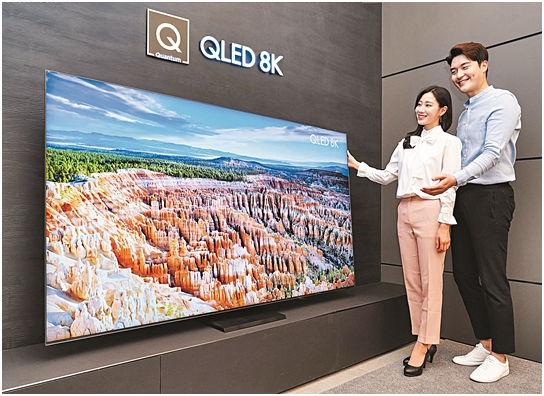Samsung’s TV Competitiveness Remains Intact Despite LCD Panel Supply from Outside

While Samsung Electronics’ Consumer Electronics (CE) Division’s display purchases have been halved over the past two years, its TV sales have increased 1.5-fold. This means that the main determinants of the company’s TV competitiveness are system-on-chip (SoC) and quantum dot (QD) technologies rather than displays. For this reason, industry experts say that Samsung Electronics will have no problem in retaining top spot in the TV market even if it does not receive liquid crystal displays (LCDs) from Samsung Display beginning 2021.
The CE Division’s spending on display panel purchases was cut in half from 5,793.8 billion won in 2017 to 3,179.7 billion won in 2019. The share of displays in the division’s raw material costs also dropped from 27.1percent to 15.7 percent in the same period. Most of the displays purchased by the CE division go into TVs, with only some of them used for other electronic products such as monitors.
What dragged down Samsung Electronics’ display purchase spending is the steep fall in prices of new LCD panels over the past two years due to massive shipments from Chinese companies such as BOE or CSOT. The price of a 4K 55-inch LCD panel plunged from US$222 in January 2017 to US$110 at the end of 2019.
On the other hand, Samsung Electronics’ global TV market share in terms of sales value increased from 26.5 percent: to 30.9 percent in the same period. Samsung TV sales also soared from US$22.57 billion to US$32.63 billion in the same period, according to market research firm Omdia. Based on their lower panel prices, Chinese companies such as Xiaomi, Hisense, and TCL waged a price war, but Samsung boosted its profitability. However, Samsung’s share of the global TV market in terms of sales volume inched down from 20.0 percent in 2017 to 19.8 percent in 2019. The Korean TV giant put profit before sales volume.
TV industry insiders say that Samsung Electronics has boosted the added value of its TV business through QD sheets, semiconductors, and software technology rather than displays. “The SoCs for Samsung Electronics TVs are loaded with central processing units (CPUs), graphic processing units (GPUs) and neural network processing units (NPUs), and these SoCs can be found only in Samsung TVs,” said Kim Hyun-seok, head of the CE Division, when asked about what makes Samsung TVs technologically superior to other products. He met reporters at CES, the world’s largest IT and home appliance exhibition held in Las Vegas, the United States, in January ”I think it will take other TV companies such as Chinese TV markers several years to make such SoCs.” In particular, Samsung Electronics is generating profits in the premium TV market through QLED TVs, which offers improved TV picture quality by attaching QD sheets to LCD panels.
TV industry experts note that Samsung Display’s recent decision to halt production of LCD panels within 2020 was made in connection with Samsung Electronics’ strong confidence in producing high-quality TVs regardless of which panels are used. Samsung Electronics receives about one-third of TV display panels from Samsung Display, and is also receiving them from Chinese companies such as Taiwan’s AUO and China’s BOE and CSOT.
Samsung Electronics’ 2020 QLED 8K TV clearly shows the wide technological gap between the company and its Chinese rivals. Samsung applied many new AI technologies to the product to improve its image quality and sounds. the company boosted image density by adding deep learning technology to the AI Quantum Processor, which upgrades image quality. The OTS function recognizes the movements of objects in a video, allowing sounds to follow them. The Q-Symphony function finds optimal sounds using TVs and speakers in sound bars. Chinese companies such as TCL, Haier, Xiaomi, Hisense, Skyworth, and Changhong still have a long way to go in these technological sectors.
Samsung Electronics plans to achieve another “super-gap” in the display sector based on micro LEDs or QD displays and quantum nano emitting diodes (QNEDs) which Samsung Display is expected to roll out in the second half of 2021. Through this, Samsung Electronics will compete with OLED TVs led by LG Electronics in the luxury TV market while preserving profits with QLED TVs in the mid- and high-priced TV market.